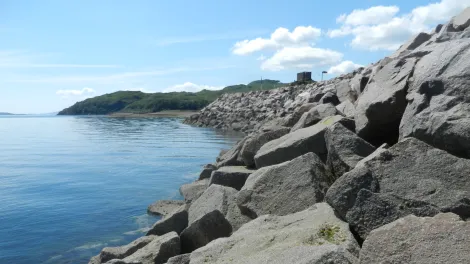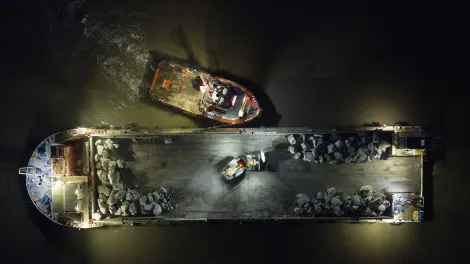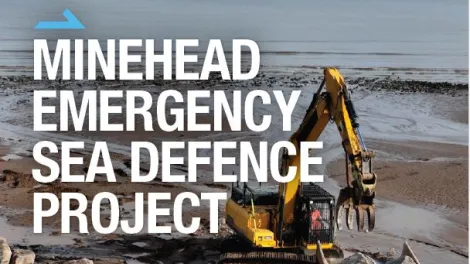Innovative Approaches for Coastal Protection

Coastal areas are more than just attractive natural landscapes in which to relax, participate in leisure activities or simply take in some stunning views. They are also vital in maintaining both the environment and local economies.
However, with climate change causing sea levels to rise, these valuable areas do face significant threats, particularly within low-lying regions of the UK. And, as the threats to our coastlines grow more severe, innovative sea defence solutions are becoming increasingly significant.
Complementing traditional hard engineering defences, such as seawalls, groynes and revetments, these new approaches aim to safeguard our coastal areas, ensuring they continue to sustain established communities, infrastructure, ecosystems and the economy.
The impact of coastal erosion
The British Geological Survey notes that low-lying coastal areas are particularly vulnerable to inundation. However, with an increase in both sea levels and storm intensity, the impacts could extend further than previously anticipated.
The susceptibility of Britain's coastline to erosion is significant, with as much as 15.5% considered highly susceptible. Soft sediment coastlines, particularly on the east coast of England, are eroding more rapidly due to increased wave attacks. This erosion is not just a loss of land but a threat to homes, businesses, and historical sites.
Communities and infrastructure
The implications of coastal erosion are profound. Over 520,000 properties in England, including 370,000 homes, are at future risk of damage from coastal flooding. The potential number of homes at risk is above one million, affecting not just rural areas but cities as well.
Infrastructure is also at risk, with thousands of kilometres of major roads, railway lines and stations vulnerable to coastal flooding or erosion by 2100. The loss of land and the threat to properties and infrastructure force difficult decisions about whether to defend, realign or retreat.
Ecosystems
Natural coastal defences such as sand dunes, salt marshes and sea cliffs protect against waves and storm surges but are declining in area. These environments, crucial for biodiversity and natural coastal protection, have seen a significant reduction in extent over the decades. The loss of these natural defences not only affects the wildlife that depends on them but also reduces the natural protection they provide to coastal communities.
The limitations of conventional approaches to coastal defences
Conventional coastal management, predominantly featuring hard engineering solutions, has shown significant limitations. While structures like seawalls and groynes effectively prevent erosion in specific areas, they are expensive, environmentally intrusive, and often result in shifting the problem to other parts of the coastline.
Soft engineering approaches, which aim to work with and complement the physical environment, offer more sustainable solutions but do not necessarily prevent erosion. They manage it by using ecological principles and practices, which have less negative impact on the natural environment. However, both hard and soft engineering methods have their drawbacks, often leading to a change in where and how erosion occurs, rather than preventing it altogether.
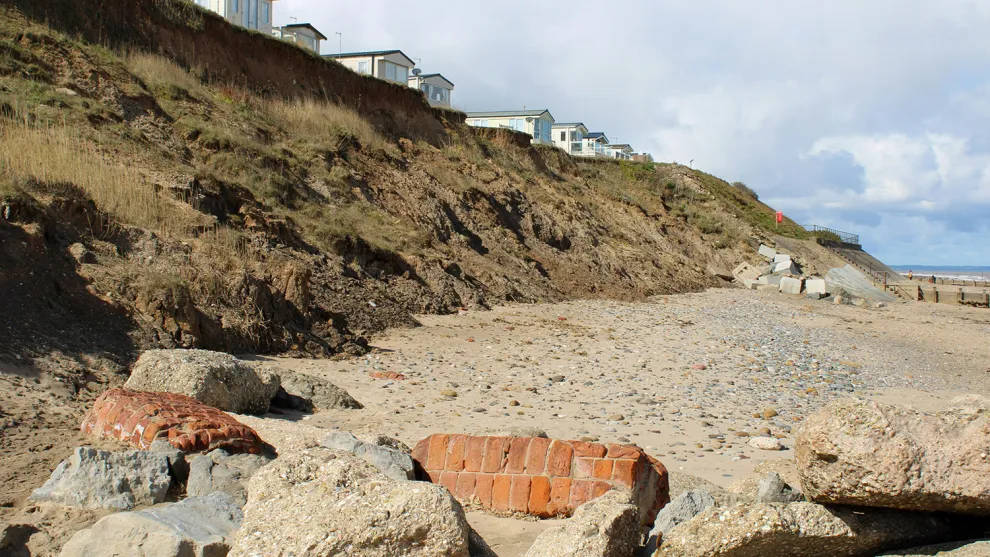
The importance of innovation and adaptation
The limitations of conventional sea defence methods have prompted a shift towards more innovative and sustainable solutions. This transition recognises the need for a more holistic approach to coastal management, considering the interconnectedness of different sections of the coastline and the dynamic nature of coastal environments.
Integrated Coastal Zone Management has emerged as a method where all coastal elements (land, water, people and the economy) are managed with one integrated strategy. This approach aims to protect the coastal zone while allowing sustainable development and involving all stakeholders in the decision-making process.
Innovative solutions also include the enhancement of natural defences such as sand dunes, which not only protect the shoreline but also provide habitats for wildlife and recreational spaces for humans. These solutions emphasise the importance of preserving and enhancing the natural processes that have protected coastlines for thousands of years.
As we move forward, the evolution of sea defence solutions continues to be driven by the need for more sustainable, cost-effective, and environmentally friendly approaches. The challenge lies in balancing the protection of coastal communities and infrastructure with the preservation of natural landscapes and ecosystems, ensuring a resilient and sustainable future for our coastlines.
Innovative approaches to coastal protection
Innovative approaches in coastal protection are increasingly vital as climate change and rising sea levels pose new challenges. These approaches range from nature-based solutions and advanced engineering techniques to technology integration, each offering unique benefits and effectiveness.
Nature-based solutions
Nature-based strategies are gaining traction for their many benefits and effectiveness. These include restoring tidal habitats, such as kelp beds, oyster reefs and seagrass meadows, which protect against coastal erosion and flooding while also enhancing biodiversity.
Sandscaping is a pioneering approach to coastal management that involves depositing a substantial amount of sediment in a specific location, designed to allow natural processes to distribute it where needed. When appropriately placed and designed, this method can be cost-effective, and its large scale and dynamic nature can enhance amenities, tourism and habitats. However, in the UK, sandscaping will be effective only if it represents the optimal local solution, supported by a competitive business case and with the backing of the community.
Dune regeneration enhances coastal defences by artificially building up dunes and increasing vegetation, such as marram grass, to strengthen them against erosion. This process includes constructing new sand dunes as barriers, planting stabilising vegetation and installing structures like boardwalks and fencing to protect the area. These efforts help preserve the fragile dune ecosystem from human activities, maintaining a natural buffer that absorbs storm energy and supports the surrounding environment's ecological balance.
Advanced engineering techniques
Advanced engineering techniques are evolving to meet the complex demands of coastal protection. These include breakwaters and artificial reefs, which are designed to reduce the energy of incoming waves, thereby protecting the shoreline. These structures are often constructed using eco-friendly materials to minimise environmental impact.
Floating structures are another innovative solution, adapting to rising sea levels and providing flexible protection options. Wave energy converters not only protect the coast but also harness the power of the sea to generate renewable energy. These advanced techniques are being designed to work in harmony with nature, providing robust protection while preserving or enhancing the coastal environment.
The integration of technology in coastal protection
The integration of technology in coastal protection is revolutionising how we understand, monitor, and defend against the forces of nature. As these technologies continue to evolve and integrate, they promise to provide a more sustainable and secure future for coastal areas worldwide.
From AI-driven early detection systems to the use of artificial neural networks (ANN) for evaluating coastal schemes and enhancing nature-based solutions, these innovative approaches offer a more dynamic, responsive, and effective way to protect our coastlines.
Remote sensing and AI for early detection
Japan is pioneering an observation system set to launch in 2024, aimed at preventing coastal erosion nationwide. This system utilises AI to analyse images from satellites and drones, automatically identifying coastlines and monitoring changes over time.
By drawing lines along the coast in images and sorting them chronologically, the AI can detect early signs of coastal erosion. This early detection is crucial for local governments to take timely disaster prevention and mitigation measures, such as constructing breakwaters and wave-dissipating blocks. This approach significantly reduces the need for extensive manpower while covering Japan's extensive coastline, the sixth-longest in the world.
Artificial neural networking for coastal scheme evaluation
Sand engines are a type of beach nourishment where a large volume of sediment is added to a coast. In a groundbreaking study, more than 500 numerical simulations with different sand engine designs along Morecambe Bay in the UK were conducted. The data from these simulations was used to train twelve Artificial Neural Network ensemble model structures to predict the influence of different sand engines on water depth, wave height and sediment transports.
The ensemble models were then integrated into a Sand Engine App developed in MATLAB. This app allows users to input sand engine designs and receive predictions on their impact on numerous variables. This novel framework exemplifies how numerical modelling and AI can be integrated to evaluate and predict the effectiveness of coastal protection schemes.
Combining nature-based solutions with AI
The integration of technology isn't just about hardware and software. It's also about enhancing nature-based solutions. For instance, restoring tidal habitats like kelp beds, oyster reefs and seagrass meadows can protect against coastal erosion and flooding. When combined with AI and remote sensing, the effectiveness of these natural defences can be monitored and predicted over time, ensuring they are functioning as intended and adapting to any changes in the coastal environment.
AI-driven solutions for real-time monitoring and adaptive responses
AI is at the forefront of real-time monitoring and adaptive response strategies. By analysing data from various sources, AI can provide real-time insights into coastal conditions, predict potential issues before they arise and suggest the best course of action. This proactive approach is crucial for adapting to the dynamic nature of coastlines and the increasing unpredictability brought about by climate change.
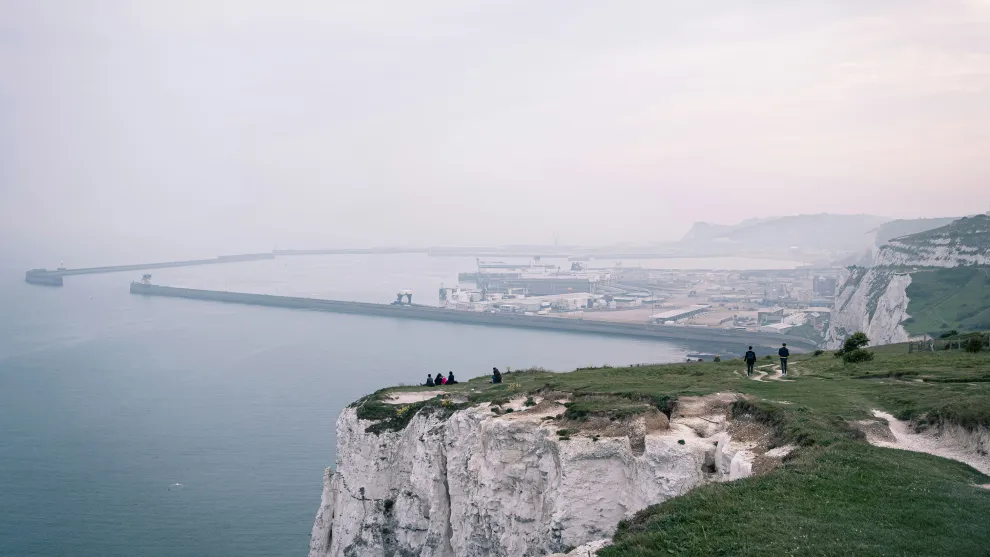
Pioneering coastal defence in action
In the following section, we look at a series of compelling case studies that illustrate the innovative and adaptive strategies being employed across the UK to combat coastal erosion and the impacts of climate change. These real-world examples showcase the practical application of both traditional and innovative approaches, highlighting the successes, challenges and lessons learned in the quest to protect and preserve our valuable coastlines.
Coastal Transition Accelerator Programme
The UK government has allocated £36 million to the Coastal Transition Accelerator Programme (CTAP). This initiative aims to explore innovative adaptation strategies in areas particularly vulnerable to coastal erosion, focusing initially on East Riding of Yorkshire and North Norfolk. These regions have been selected due to the high percentage of properties at risk over the next two decades.
The CTAP will support local communities in planning and preparing for long-term coastal changes while implementing immediate actions to enhance resilience. Proposed interventions include upgrading community infrastructure, repurposing land in erosion zones, exploring innovative finance mechanisms for relocation and adapting local planning systems to manage the transition of communities from high-risk areas.
Floods Minister Rebecca Pow emphasised the importance of adapting to the increasing threats posed by climate change, stating, "As climate change brings more extreme weather, we must redouble our efforts to build a more resilient nation." She highlighted the programme's role in supporting innovative solutions for areas most vulnerable to coastal erosion.
This programme is part of a broader commitment by the government, which includes a record £5.2 billion investment in flood and coastal defences between 2021 and 2027, aiming to protect 336,000 properties and reduce economic damages. The CTAP, running until March 2027, will not only address immediate needs but also contribute to the national policy direction and coastal resilience strategies.
Resilient Coasts - Great Yarmouth and East Suffolk
The Flood and Coastal Resilience Innovation Programme is a £150 million initiative by the UK government, designed to empower local authorities, businesses and communities in 25 selected areas to test and demonstrate innovative and practical resilience actions in response to the evolving climate.
This programme sets the stage for projects like the Resilient Coasts - Great Yarmouth and East Suffolk. This pioneering initiative is aimed at enhancing the resilience of coastal communities in Norfolk and Suffolk, which are regions known for having some of Europe's fastest-eroding coasts. With over 2,500 homes at direct risk and thousands more affected by the loss of property, infrastructure, and utilities, the project seeks to transition from reactive to proactive and planned solutions for coastal management.
The project will implement an ambitious resilience programme, delivering real adaptation and resilience options for communities. This includes a comprehensive suite of planning, engagement, technical, financial and policy tools to support coastal transition, which could be applied across the UK coast. The initiative will operate in five core pilot locations across the Norfolk and Suffolk coast, plus four additional ‘twin’ locations, in close collaboration with communities and a multi-sector national group of partner organisations.
Key components of the project include a Coastal Adaptation Toolkit to plug existing gaps and offer new tools based on evidence, supporting co-created community resilience plans. The project aims to create a sustainable transition framework, serving as a blueprint for resilient coasts that are socially, economically and environmentally viable. The legacy of the project is to establish a 30-year catchment-based, coastal management approach that creates climate-resilient places by 2045.
East Suffolk Council leads the project, working with Great Yarmouth Borough Council and Coastal Partnership East, among other partners. This collaborative effort represents a significant step towards addressing the urgent need for coastal adaptation and resilience in the face of rapid erosion and climate change.
The Bacton to Walcott Coastal Management Sandscaping Scheme
In 2019, North Norfolk District Council led a multi-partner project to address the devastating impacts of the 2013 North Sea Surge. Inspired by a Dutch concept (Zandmotor), the scheme placed approximately 1.8 million cubic metres of sand on the beaches between Bacton and Walcott.
This initiative significantly increased the beaches' height and width, aiming to provide natural protection by improving beach levels to absorb sea forces before they reach the cliffs and defences. The scheme was crucial for protecting the Bacton Gas Terminal, a vital infrastructure processing up to one-third of the UK's gas demand, and for enhancing erosion and flood protection for the local communities.
The performance of the scheme is continuously monitored through various methods, including bathymetric surveys and light detection and ranging assessments, with additional research being undertaken by universities. Initial short-term analysis after construction showed an overall gain in sediment, with the beach moving towards a more natural profile and less vulnerability to significant changes. Long-term insights up to November 2020 indicated that the overall sediment loss was in line with design predictions and, despite some losses, there was a net gain in sediment.
By June 2021, further observations suggested that the scheme was performing largely as modelled, with waves breaking further out to sea, indicating significant energy absorption before reaching the cliffs and defences. However, windblown sand was identified as a potential risk, leading to the proposal and trial of mitigation measures. Additionally, ongoing monitoring of breeding birds indicated no significant impact from the construction works.
Overall, the Bacton to Walcott Coastal Management Sandscaping Scheme represents an innovative approach to coastal protection, demonstrating effectiveness in sediment management and beach profile transformation while being responsive to environmental changes and community needs. As it evolves, the scheme continues to offer protection and contribute to the area's biodiversity and natural landscape.
The West Sands Dune Management project
Initiated in 2010 at St Andrews in north-east Scotland, this initiative represents a significant endeavour in large-scale dune restoration. It was put in place in response to a storm surge that breached the dune system, flooding farmland and parts of the renowned St Andrews golf courses. The dunes, part of the Eden Estuary Site of Special Scientific Interest (SSSI) and the Firth of Tay and Eden Estuary Special Area of Conservation, provide natural protection against high tides and rising sea levels.
The West Sands Partnership, formed to address these risks, employed a Building with Nature approach. This method utilised natural sand transport to reprofile the dunes, aiming to reinstate their flood protection function in a self-sustaining way. However, due to the heavy use of the dune system, it was necessary to manage pedestrian access and stabilise some areas by installing fencing and planting dune grasses, ensuring all work was compatible with the conservation of the designated areas.
The project has delivered several environmental and societal benefits. The enhanced dune ridge now offers more resilient protection from coastal flooding and erosion, while the introduction of signed paths, manual litter picking, fencing and sheep grazing has reduced pressures on coastal habitats. Notably, monitoring by Fife Coast and Countryside Trust has indicated successful breeding of ringed plovers at Outhead, a first since 2005. Additionally, the dune habitats within the SSSI were deemed to be in a 'recovering' condition in 2016, partly due to the restoration efforts.
Recognising the long-term nature of coastal management, the project partners have accepted that dune restoration will likely be an ongoing requirement, making it an integral part of the site's mid-to-long-term management strategy. This case exemplifies the commitment to preserving natural landscapes while adapting to and mitigating the impacts of extreme weather and sea-level rise.
Blue Anchor Coastal Defence
In a bid to bolster the coastal defences of Blue Anchor beach near Minehead in Somerset, Aggregate Industries undertook a significant project, supplying 13,500 tonnes of granite Armourstone from its Scottish super quarry, Glensanda.
The £3.8m scheme, led by Somerset Council and executed by Kier Integrated Services, aimed to protect the cliffs, walls and the B3191 road from ongoing erosion. The granite, transported via three sailings of the MV Hagland Saga, each carrying 4,500 tonnes and taking 21 days to complete, was transferred to the company’s SeaRock barge for the final stage of delivery to the beach.
Stephen Dryden, Regional Director for North, Scotland and Overseas at Aggregate Industries, reflected on the project's scale and significance, stating, “Logistically, it was no mean feat to transport 13,500 tonnes of granite from Western Scotland to Somerset but it really demonstrates our capabilities.” He also highlighted the environmental benefits, noting, “Transporting by sea in this way also eradicated the need for more than 700 vehicle journeys.” The project not only showcased Aggregate Industries' ability to deliver large-scale coastal defence schemes but also their commitment to sustainable practices.
Councillor Sarah Dyke, Lead Member for Environment and Climate Change at Somerset Council, expressed her satisfaction with the project, remarking, “I am delighted to see these important works finally take place, benefiting the communities in West Somerset. The scheme will provide a more permanent defence against coastal erosion.” This initiative stands as a testament to the collaborative effort between local authorities, contractors and suppliers to protect and preserve the UK's vulnerable coastal areas through innovative and sustainable solutions.
Read the full case study here.
Conclusion
As we've explored throughout this article, the UK's coastlines are not just picturesque landscapes but are crucial for environmental balance, local economies and community wellbeing. However, the escalating threats posed by climate change, such as rising sea levels and increased storm intensity, have made the need for innovative sea defence solutions more pressing than ever.
We've seen how traditional hard engineering methods, while effective in certain scenarios, come with limitations and can often shift problems elsewhere along the coast. The emerging focus on soft engineering and nature-based solutions offers a more sustainable and holistic approach, working with the natural environment to manage erosion and enhance coastal resilience. Techniques like sandscaping, dune regeneration, and the use of advanced engineering and technology signify a promising shift towards embracing innovation in coastal defence.
However, the journey doesn't end here. The fight against coastal erosion and the effects of climate change is ongoing and requires the collective effort of governments, communities, scientists and industries. It's about adapting to the changing environment, learning from each project and continuously seeking ways to improve and innovate.
As we move forward, let's take inspiration from the innovative approaches discussed and commit to a future where our coastlines are not only protected but thrive. Whether you're a policy-maker, a community member or simply someone who loves the coast, your voice and actions matter. Support local and national initiatives, participate in community planning and advocate for sustainable practices. Together, we can ensure that the UK's coastlines remain vibrant, safe and beautiful for generations to come. Let's not just defend our coasts; let's celebrate and sustain them.






